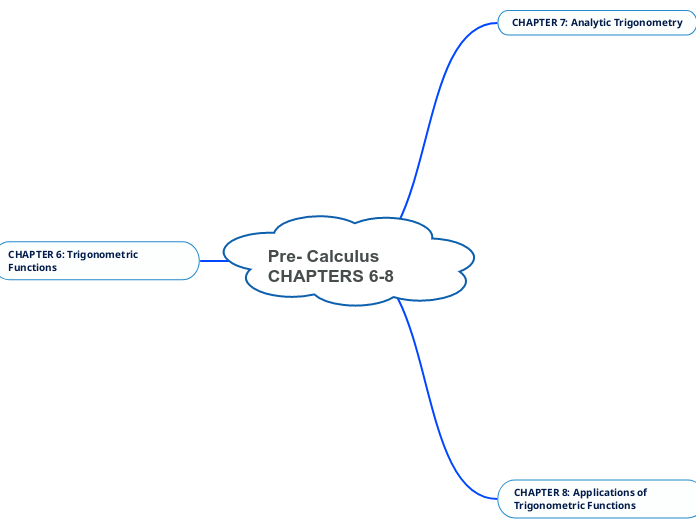Pre- Calculus CHAPTERS 6-8
CHAPTER 6: Trigonometric Functions
MAIN KEYS
Convert between Decimal and Degree, Minute, Second that Measures for Angles
When a ray, or half-line is a portion of a line that starts at a point V on the line and extends the indefinity in 1 direction
When two rays are drawn into the common vertex they form a ray of angle for the initial side
An angle 0 = standard position for the vertex at the origin of the rectangular coordinate system and the initial side for the coincides and positive x-axis
Angles and Degree Measure
The angle is formed by the rotating initial side that is exactly once in the counterclockwise and direction to = 1 revolution
One degree, is 1/360 revolution
Convert from the Degrees to Radians and from Radians to Degrees
Subdivisions of a degree may be obtained by the use of decimals, the notion of minutes and seconds
One minute , is 1/60 degree
One second, 1/3600 degree
1 counterclockwise revolution= 360 degrees
Find the Area of a Sector of a Circle
0 measured in radians, is a central angle of this circle.
consider a circles of a radius r and two central angles
Theorem Area of a Sector
The area A of the sector of a circle of radius r formed by a central angle of 0 radians
Find the Linear Speed of an Object
Distinguish the linear speed v of the object
v= s/t
w= 0/t
Key Terms
CHAPTER 7: Analytic Trigonometry
MAIN KEYS
The Inverse Sine, Cosine, and Tangent Functions
Define the Inverse Sine Function and the horizontal line y=b and where b is between the -1 and 1
Intersects the graph of y=sin x infinitely many times for the horizontal line test
The Inverse Trigonometric Functions
Define the Inverse Secant, Cosecant, and Cotangent Functions
Most calculators do not have the keys to find the inverse cotangent, cosecant, or secant function
Evaluate them by converting the inverse trigonometric functions
Trigonometric Equations
Solving Equations by a Single Trigonometric Function
Using a calculator
Quadratic in Form
Fundamental Identities
Using a Graphing Utility
Trigonometric Identities
Identically Equal, Identity, and Conditional Equations
f(x)=g(x)
Two functions f and g are identically equal
For every value of x both of the functions are defined
Sum and Difference Formulas
The derivation of trigonometric identities by obtaining formulas involves the sum or the difference of two angles
Use the Unit Circle to find the formulas
Double- angle and half-angle Formulas
In order to find the formulas use:
Find Established Identities
Find Exact Values
Double- Angle Formulas to find Exact Values
Product-to-Sum and Sum-to-Product Formulas
Express Products as Sums
Express Sums as Products
Use the derive formulas for writing the products of sines or cosines as sums or differences
CHAPTER 8: Applications of Trigonometric Functions
Right Triangle Trigonometry; Applications
A triangle is one angle that has a right angle (90 degrees)
The opposite side of the right angle is called the hypotenuse
The Law of Sines
If none of the angles of a triangle is a right triangle it is called oblique
Solve SAA or ASA Triangles
Solve SSA Triangles
Solve to Applied Problems
The Law of Cosines
The square of one side of a triangle is equal to the sum of the squares of the two other sides and subtract twice their product times the cosine of their angle that is included
Solve SAS Trangles
Solve SSS Triangles
Solve Applied Problems
Area of a Triangle
The area N of a triangle is N=1/2 bh
Solve for the Area of SAS Triangles
Solve for the Area of SSS Traingfles
Simple Harmonic Motion; Damped Motion
Build a Model for an Object in Simple Harmonic Motion
Analyze the Harmonic Motion
Analyze the Damped Motion
Graph the Sum of Two Functions
